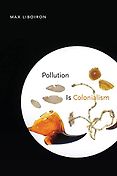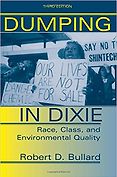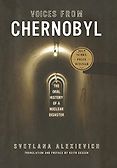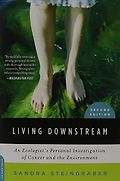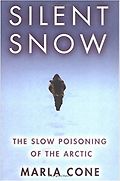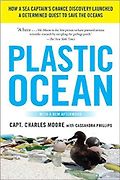It’s been four years since we asked you to choose the best books on pollution. I think you want to add a recommendation.
Selecting five books on a topic is pure folly. I knew that from the get-go. But I was accurately aware that my list felt incomplete because the book I most wanted to read (let alone recommend) on pollution was, at the time, still being drafted by Max Liboiron, a plastic pollution researcher with a background in both art and science and technology studies. Liboiron’s much-anticipated Pollution is Colonialism was published in 2021 by Duke University Press, and I welcome the chance from the Five Books editors to update this entry to include it.
Liboiron is Métis/Michif and their lab, Civic Laboratory for Environmental Action Research, is based in the Department of Geography at Memorial University on the island of Newfoundland. Pollution is Colonialism explains how the pollution and plastics that Liboiron and colleagues study doesn’t begin in a factory or even within industrial systems. Rather, as Liboiron lays out, the ultimate source of pollution is the violent and ongoing colonial systems of land relations on which Indigenous land was presumed available for the extraction of so-called resources and industrial feedstocks; for the construction of factories; and for the presumed assimilation and storage of wastes. But, for Liboiron, science, including the environmental sciences, a field in which Liboiron has also made notable scientific, theoretical and methodological contributions —they were recently nominated by their peers to the Royal Society of Canada— can also enact, enable and reproduce these same relations, however well-intentioned or passionate its practitioners may be.
Pollution science, as the book makes clear, can both harbor and channel colonial norms and practices, too, which in turn shapes how science and regulators see pollution, or don’t, and how they permit or otherwise bureaucratically sanction the use of the environment as a receptacle for pollution, in the process advancing the ongoing colonial project and metering out further harm.
Pollution is Colonialism is an engaging, generative read, compact in length, but expansive in insight. Written with wit, intellectual generosity and in a wholly exciting format despite its academic credentials–one in which the footnotes are as readable and thought-provoking and essential as the body of the book itself.
[end of addendum]
___________________________
The meaning of ‘pollution’ changes across time and culture, and in response to new scientific understanding. What are some helpful ways to think about the term and what it describes?
The Oxford English Dictionary contains some surprisingly archaic definitions. One now obsolete use is ejaculation without intercourse, as can sometimes embarrass sleeping, pubescent boys. Another is ‘the desecration of that which is sacred.’ Milton’s Paradise Lost (published in 1667), for example, contains one such reference to the defilement, or pollution, of a temple. The idea of pollution being a material or molecular impurity emerged later, and as industrialisation proceeded. Slag piles and emissions and effluent were visible in new ways, produced in novel qualities, and contained —especially after the invention of coal-tar chemicals in the mid 19th century— new molecules and mixtures.
The anthropologist Mary Douglas argued in her 1966 book Purity and Danger that the meaning of pollution varies by context, which is a way of saying social processes assign pollution its meaning. To say something is a pollutant, for Douglas, is to determine that some object or bit of matter is ‘out of place.’ But how those boundaries are drawn, and who determines what should be where, is wrapped up in notions of order, purity, and what constitutes a good society. This sets us up to look for the social story carried by concepts like ‘pollution.’
Today, technical definitions hold sway. They vary by policy and are determined by rational/scientific processes, and in relation to another concept: contamination. There’s a lot of muddled confusion around this term, too, as casual use often treats them as interchangeable. Technically speaking, contamination is matter out of place, but at levels not considered harmful to health or biological systems. Pollution is contamination that has crossed some pre-determined threshold: it is matter out of place and in harmful quantities. That sounds straightforward. But look under the hood and one sees several assumptions driving this definition. First is that only science and scientists can define harm, and thereby pollution. Everything outside that lens or beyond what that lens can ‘see,’ often gets dismissed. This issue plays out in several of the books I recommend here.
“What constitutes ‘harm’? Is it social or is it purely biological? And, even within the biological realm, is harm death? Or more subtle than that: effects that show up in fertility and neurodevelopment or metabolism? ”
Second, what constitutes ‘harm’ in the first place? Is it social or is it purely biological? And, even within the biological realm, is harm death? Or more subtle than that: effects that show up in fertility and neurodevelopment or metabolism? Who makes this determination? And what happens when scientific research advances new understandings of harm, as has been the case with toxicology? Over recent decades, the once unquestioned pillar of toxicological reasoning —‘the dose makes the poison’— has been complicated by a new body of research on low-dose exposures. And further, ‘the timing makes the poison’ too, meaning there are certain periods during human development in which even trace level exposures can be consequential. Both upend how to set a threshold, how to define ‘harm,’ and by extension, how to define ‘pollution,’ and thereby what to do about it.
My favourite scholar to read on this is Max Liboiron, who writes about these categories and how plastics, as one type of pollutant, further muddies the definitional waters over what is a pollutant and what counts as harm.
That nature even has a ‘critical threshold’ or ‘carrying capacity,’ is itself— as Liboiron has written — another assumption. Fascinatingly, ‘carrying capacity’ is a concept, like the notion of ‘risk,’ that comes to environmental health science and policy from the shipping industry of centuries past, which calculated how much cargo a ship could transport for the purpose of levying trade duties.
‘Nature as cargo hold’ is a powerful metaphor for how governance structures approached the regulation of industry and its waste stream. It makes one think about other metaphors that might have enabled different definitions of pollution and different regulatory approaches.
What might be more appropriate metaphors for our time than ‘nature as cargo hold’? I’m thinking partly about plastics. You have written eloquently about their role in your own family history and in the common inheritance of humanity. But I’m not thinking only about plastics.
As for alternative metaphors, that’s a fascinating question, and one I haven’t considered before. Were we to stick with economic metaphors lending or borrowing comes to mind. I can see pros and cons to thinking this way. Borrowing has a built-in ethic, one that is popularly understood: What is borrowed must be returned, preferably in the same or better condition. But nature-as-on-loan, as borrowed from the future, upholds similar assumptions that (a) nature is for human use, and (b) that it is owned, though not by us, by some yet-born generation. I’m inclined to keep searching, to seek metaphors beyond economics, however much a sharing and lending economy sounds lovely on its face.
I’m reminded that the biologist and activist Sandra Steingraber has pointed out that modern industry exists within two ‘eco’ systems: the economy and also ecology. Both, she points out, derive from the same Greek root, oikos, meaning house. So, economy is the management of the home, and ecology, its study. Yet, as concepts, they exist far from each other, and even made to seem at odds. It is instructive to think about why, given how much a healthy economy depends on a well-functioning ecosystem, and how much profit has depended on waste being relatively cheap, if not free, to offload. For example, factories were built alongside rivers for power, yes, but also as conduits to flush effluent ‘away.’
And this thing that emits waste—the factory, also called a ‘plant’—sits at the interface of these systems, taking in natural resources, metabolising them, and then putting out wonderfully useful, even lifesaving, goods and also wastes of consequence to biology, ecology and possibly evolution.
But let’s pause on this for a second: could there be an ecological metaphor —plant! — right in the centre of our economies? I’ve been working on this question for a couple years now — how we came to call factories plants. And I don’t yet have an answer, or at least one that sufficiently satisfies my curiosity. ‘Plant’ might be a remnant of a now dated use of the word, which is the layout or plans for a structure or building. But it is hard to resist the possibility that these houses of production bear some deeper connection to ecology — if only in metaphor. Returning to your question, can this metaphor be productively mined for how to design industry so that we may dwell and thrive and produce useful things, all within an ecological system?
This means that emissions/effluent from one system would feed into the next, and the next, and the next, at some point traveling in a circle. The chemical and plastics industries feeds on the waste products of fossil fuel refinement, first coal tar, then oil, and increasingly the byproducts of gas extraction. I suppose that’s a start. But this system isn’t closed, as the scientist Barry Commoner pointed out in the 1970s. It’s still linear. There’s an end, an endpoint. And that end remains: waste, by-products, contaminants, pollutants.
All of this makes me think of story that the writer and chemist Primo Levi tells about trees. During World War Two, Levi was imprisoned at Auschwitz, and because of his training in chemistry, forced to work in the laboratories at the nearby BunaWorks, a massive industrial complex run by IG Farben that made synthetic rubber from coal-tar for the German Army. There, Levi dreamt of trees. To him, trees were the original chemical factory. They inhaled carbon dioxide and exhaled oxygen, all the while absorbing light and reshuffling atoms of carbon. But trees worked carbon with a quiet, elegant chemistry that is “refined, minute, and quick-witted.” Nothing like the ‘plant’—concrete and metal, roar and soot, belch and foul — where Levi laboured. Levi’s tree is an object lesson, or perhaps an ideal for how to make energy and useful materials while allowing carbon to cycle without too much interference.
And really human handling of carbon accounts for a good portion of pollution and environmental problems today. Climate change, plastics and persistent organic (or carbon-based) pollutants all share a common origin in the human relationship to carbon. This, too, is another point that Steingraber makes, in this case in her book Living Downstream, and it brings the conversation back around to trees. Think, she says, of climate change and poisoning of the biosphere by things like persistent organic pollutants, or POPs, and plastics as trunks of the same tree, a tree with roots in the fossil fuels underfoot.
OK, since you mention Steingraber let’s come on to Living Downstream. Why did you choose this?
Living Downstream is a beautifully rendered book, part science, part history, part memoir. Steingraber’s purpose is to refocus public attention upstream, by which she means where problems begin. It is a crash course in public health, and in adopting a public health perspective on cancer and pollution prevention. Moved by its message, the filmmaker Chanda Chevannes even made Living Downstream into a documentary film of the same name.
It was a pivotal book published at a pivotal moment. Public and scientific understanding of pollution was undergoing seismic shifts. The first edition came out in 1997 — the same decade scientists released the first consensus statement outlining a more nuanced understanding of the role environmental exposures played in biology, which is that chronic, everyday exposures appeared to be interfering with the hormone signalling systems that oversee metabolism, fertility, neurodevelopment and more. The United Nations had also begun moving toward what would become the 2001 Stockholm Convention on Persistent Pollutants, an international treaty that works to move the most persistent, bio-accumulative and toxic pollutants out of production systems. The first pollutants listed to the Convention included dioxins and furans, PCBs, and a number of the highly chlorinated pesticides described by Rachel Carson in Silent Spring: chlordane, dieldrin, aldrin, endrin and, the best known, DDT. Many of these were, and are, present in the environment –and in our flesh and blood in ways that we can’t easily register or perceive. Pollution as potentially invisible, as mobile, as pervasive, as cumulative, as unevenly distributed around ‘hot spots,’ as significant in trace levels, and as preventable: this was the scientific and political context in which Steingraber wrote Living Downstream.
Steingraber was uniquely posed to write on this topic. She holds advanced degrees in both biology and English, and is a skilled scientist and a commanding writer, unparalleled in her ability to make complex environmental science accessible to a general audience. I wouldn’t be the first to call Steingraber our generation’s Rachel Carson, and Living Downstream the sequel to Silent Spring. What makes Living Downstream all the more compelling is Steingraber’s story and her personal, if unexpected connection to both cancer and to Carson.
“I wouldn’t be the first to call Steingraber our generation’s Rachel Carson, and Living Downstream the sequel to Silent Spring. ”
Like Carson, Steingraber, too, had battled cancer. It was in fact a disease that ran in her family. But—and here’s the thing—Steingraber was adopted, which forced her to ask: what else do families have in common besides genes? Her answer: families also share watersheds, airsheds and foodsheds, and whatever pollution has become a part of them. Living Downstream reads like an investigation into what role environmental factors like pollution play in the complex origins of cancers.
In truth, my favourite books are wonky, historical dives into the history of chemistry and chemical engineering, which, to me, reveal much about the social, technical and political origins of today’s pollutants. These are the books I most love. But I realise I’m an odd-duck to devour them as I do. Steingraber takes this history and rewrites it narratively, tying the surge in plastics and organic chemical production to WWII geopolitics and post-war economics. I appreciate (and often study) how she makes not just science, but also science history compelling for her readers.
The newly revised edition, published in 2010, updates the science, which exploded between 1997 and then. Steingraber followed Living Downstream with two other books about foetal and child health, making an elegant trilogy of science and her experience of pregnancy and motherhood. Somewhat tellingly, I read all three of these before going back and finally reading Carson again, who I found to be as relevant today as was when Silent Spring first appeared in print.
Your second choice is Robert Bullard’s Dumping in Dixie. Why is this book significant and what is its continuing relevance given it was published nearly twenty years ago?
In Dumping in Dixie, Robert Bullard—a sociologist, and a towering figure in the field—documents the emergence of the US environmental justice movement, born from the Civil Rights movement, its networks, organisations, and framing. Through the story of one community in particular, he explains how pollution and racism operate together, and through one another.
Here’s the outline of the story Bullard tells: In the late 1970s, just after the US Congress had curbed the production of polychlorinated biphenyl, or PCB, and placed stricter rules around the handling of industrial waste, a small company illegally unloaded PCB-laced oils along state roads in North Carolina. Clean-up ensued, but then there was the problem of what to do with all that contaminated soil. Where should it go? That somewhere, following the official selection process, was a community in rural Warren County, North Carolina called Afton—a majority African American region of the state and where nearly a quarter of residents lived in poverty. Here, it was determined, a special landfill would be constructed to receive the PCBs. Residents resisted, laid their bodies in the road to block the trucks.
These events are imperative to keep in living memory, and why this book also remains a must-read though first published in 1990. Warren County continues to organise around issues posed by the landfill that was eventually built. (Last year, The New Yorker ran an article last year on Warren County; a recent book also revisits the place).
Dumping in Dixie sparked a new genre of books, and a rich area of social scientific research to unpack the social, political and economic processes that underly how industrial facilities and landfills are cited, and why —time and again— transit corridors, and heavy industry and their wastes are put nearer poor communities, and communities of colour. And though books bring much needed attention to these often-invisible issues, sadly, so do natural disasters.
Get the weekly Five Books newsletter
The hurricane that struck Houston and the Gulf Coast of Texas in August 2017 made these unjust juxtapositions strikingly visible and all the more dangerous for those communities sharing fence lines with that region’s dense network of petrochemical facilities. Bullard, who lives in Houston, spoke eloquently in the aftermath of Hurricane Harvey about how natural disasters “widen and exacerbate” existing environmental inequalities. As a result of storm-related shut-downs (and later restarts), factories there released pollutants in excess of their already problematic releases. And more, floodwaters inundated the region’s Superfund sites, those polluted sites deemed significant enough to warrant federal oversight by the US government. These are places engineered to ‘contain’ pollution, and yet, in some instances, the floodwaters exposed what those sites harboured as well as the conceit of containment in the first place.
“Bullard, who lives in Houston, spoke eloquently in the aftermath of Hurricane Harvey about how natural disasters “widen and exacerbate” existing environmental inequalities. ”
Which brings me to one final point, which is that Dumping in Dixie raised up the twin legacies of pollution and the systems for handling it—how these systems beget harms of their own. Building on this, The Center for Investigative Reporting did a fascinating investigation on this a few years back, tracking the flow of wastes ‘cleaned up’ from Superfund sites.
Following the post-industry, post-remediation trail of pollution goes right to the heart of the dilemmas we are discussing. What becomes of policies/systems that focus at the proverbial ‘end of the pipe’ rather than upstream and earlier in the industrial process? This is something David Pellow has written very well about in Resisting Global Toxics. Flooded Superfund and industrial sites are yet another striking example of the mobility and fluid legacy of pollution
Your third choice is Voices of Chernobyl: The Oral History of a Nuclear Disaster by Svetlana Alexievich. This is about a very different kind of pollution and one that we have not so far discussed. Nuclear radiation is often poorly understood, at least by many of us who are not specialists. The issues are complex, and it can sometimes seem as if we receive conflicting messages. On the one, hand we’ve been taught to fear radiation like, perhaps, little else. On the other hand, some reporting notes that few people have actually died from the effects of radiation following disasters like Chernobyl — at least compared to, say, the ongoing death toll from pollution from coal-fired power plants. Moreover, plants and wild animals thrive in the area around Chernobyl now that is has largely been abandoned by people. What can we learn from Alexievich?
What follows events like Chernobyl is a politics of measurement. Who counts? What counts? Who does the counting? How are boundaries drawn for the purposes of counting and comparing? And what is discounted, or never counted at all?
On the legacy of Chernobyl and radiation history, I keep tabs on the historian Kate Brown, reading whatever she writes. What I learn from her is that, for all the questions and counting that followed the Chernobyl disaster, there remain gaps and silences — what the sociologist Scott Frickel might call ‘undone science.’
Brown says there hasn’t been sufficient research or research dollars dedicated to effects more subtle than death and of a different category of health troubles than cancers. For example, she points to studies showing correlations (though not causal links) between exposures and heart conditions and also birth defects, and writes about the history of what is and isn’t known about Chernobyl even today, decades on. These gaps, silences, incongruences, and uncertainties are an important piece of what it means to live in this moment.
And you’re right, life resumes inside the Exclusion Zone. There is resilience and resolve and also radiation, and all of it makes up life there. Radiation is one part of a bigger story, one mixed and muddled with other exposures, other experiences.
But it is the lived experience that I want to focus on, which includes living the questions, the science, the debates over what to study and how to study it. All of this makes up the social experience of a disaster, and of contamination and pollution. To sociologists, the experience of exposure matters as much as the biological exposure. It is an experience that may include being studied—what does that feel like? Or of living with uncertainty; being confused by conflicting reports or duelling experts; of warnings, and overturned warnings; and perhaps most relevant here, to how a government responds to pollution, and by its administration of pollution—how a government goes about the business of remediation, relief, redress and compensation. In his book Everything In Its Path the sociologist Kai Erikson highlights that there’s the primary experience of disaster, or in this case, exposure, and then there are the secondary effects that follow from the official (and unofficial) response to disaster or exposure. These, too, have an effect and after-effects, too. It is the totality –and the diversity—of the lived experience that I want to highlight. It certainly widens what counts as harm.
Here, disaster and pollution events are both as singular and spectacular as the explosion, and also drawn-out and accumulative, a slower form of violence, in the scholar Rob Nixon’s parlance, which takes years, perhaps decades to register.
Alexievich is a journalist — a reporter — but she is also the recipient of a Nobel Prize for Literature. What does she achieve in Voices from Chernobyl?
She crafted a series of intimate portraits based on hundreds of interviews. Each is in a different voice, and each one is striking, and singularly significant, with visceral imagery that will long stay with you. Reading becomes immersive: you feel and hear and see it, more than simply decoding text. The way disasters unfold against a perfect sky. The way they’re lived in real time — eating at the edges of a normal day, interrupting narratives already in progress, quarrelling lovers, the hanging of washing, the tending to gardens and children — versus how they’re remembered and recorded into history. The messiness of cleanup, and the sacrifices made by those doing it. The experience of a kind of pollution that can’t be seen, that can’t possibly be, not when the apples are sweet and red and ready, not when you’re young and holding the hand of a crush. The accounts build into a polyphonic chorus. Diverse, discordant.
“ Reading becomes immersive: you feel and hear and see it, more than simply decoding text. The way disasters unfold against a perfect sky. The way they’re lived in real time. ”
I’m always awed when an author crafts a structure for a work that reflects and carries its meaning. She’s done this masterfully. I once read a review, I think it was in the New York Times, how her vignettes accumulate as radioactive particles do. The experiences of Chernobyl, and the state, medical and scientific responses to Chernobyl, building, building, until finally enveloping you.
Your fourth choice is Marla Cone’s Silent Snow: The Slow Poisoning of the Arctic.
Think about the environmental issues facing the Arctic, and one thinks about warming, not the unseen accretion of pollution in its seemingly pristine environs and its dynamic food chain. As one learns in Dumping in Dixie, industrial pollution doesn’t stay put. Human activity moves it from place to place. But depending on pollutants’ molecular structure, so can wind, water and weather patterns. Heavy metals like mercury and persistent organic pollutants, or POPs, as this class of pollutants is called, can also concentrate and move up the food chain. Silent Snow describes the invisible build-up of industrial pollution, in the circumpolar North. It explores the history and science of how we came to understand this, and to realise impossible-to-see and harder-to-sense pollution was concentrating far from factories and heavy industry. Marla Cone, a journalist, argues this may be the greatest environmental injustice on Earth.
Cone makes the case for how this influx of pollution infringes on human rights and on the sovereignty of indigenous communities for whom the Arctic has been home for generations. It shows how a global environmental problem can be highly localised and uneven in its consequences.
But importantly, Silent Snow is also a story of resilience, and of the leadership of indigenous communities to press these issues at the national and international level. The extraordinary efforts of, for example, The Inuit Circumpolar Council inspired the United Nations Stockholm Convention on POPs, which today identifies and moves out of production the most toxic, persistent and bioaccumualtive classes of pollutants. We all ought to know this story, since everyone of us, in one way or another and likely without realising it, has benefited from these protections. But who among us knows this history or its significance to our collective future?
For a more first-person account, I’d also recommend Sheila Watt-Cloutier’s The Right to be Cold. Watt-Cloutier served on the Inuit Circumpolar Council, and was instrumental in moving the world toward the POPs Treaty, a role for which (in part) she was nominated for the Nobel Peace Prize.
It’s clear from its title — Plastic Ocean — that your fifth book choice relates to an issue that has been getting particular attention in recent months, at least from campaigners and in parts of the media. Plastic in the seas became a global story earlier this year, for example, when scientists reported that the beaches of Henderson, one of the remotest islands in the world, are filled with plastic.
Henderson Island, which sits in the South Pacific, made headlines in May 2017 after researchers published estimates of how much plastic had collected there. What they found was mind-boggling — something like 38 million pieces on an island that measures 5 by 10 kilometres, is presently uninhabited by humans, a World Heritage site, meaning that it is protected, and thousands of miles from major land masses or urban areas.
The island, however, sits in the middle of a fluctuating field of ‘plastic ’ the movements of which are governed by the circular currents of the South Pacific Gyre. This is a similar plastics-laced system as the North Pacific Gyre, sometimes dubbed the Great Pacific Garbage Patch, the one through which Plastic Ocean author Captain Charles Moore sailed through in 1997.
En route from Hawaii to California, Moore’s boat had drifted through, to his distress, nearly ‘seven days and a thousand miles of plastic debris.’ Your question prompted me to pull up map of Henderson Island. I was shocked to see how far away Henderson is from the areas of the Pacific Moore describe.
A recent study of the total global production of plastics —the first of its kind — also delivered some shocking numbers. Since 1950 the estimated total amount of plastics that have been made is around 9.1 billion tons. This is equal the mass of a billion elephants — or enough to cover the whole of Argentina in ankle-deep. This is an underestimation, since synthetic plastics production was well underway before 1950, accelerating and expanding in the years following WWII. But here’s the kicker: most of the plastic ever made has been produced within the most recent decades, and the rate of plastics production appears to be accelerating, especially in the category of food packaging and single-use (that is, disposable) plastics. No less stunningly, another recent study has shown that billions of people globally are drinking water contaminated by plastic particles.
Moore wasn’t the first to note plastics this far out in the ocean, but after returning to shore he became one of the key figures inspiring research and raising public awareness about marine plastics. He couldn’t put to rest what he had witnessed. He took up researching the issues himself, recruiting allies and scientists to the work. On multiple occasions, he returned to the Pacific to trawl for microplastics —for example, the small bits of pre- and post-production plastics that are less than 5 millimetres across.
After quantifying the spread and load of marine plastics, Moore went on to help document their implications and their toxicity. Plastic Ocean, co-authored with Cassandra Phillips, documents these pursuits.
When plastics are made, certain properties are designed into the material through the addition of chemical additives that impart colour, flexibility, resilience, fire resistance, and more. Plastics transfer these additives into the environment, and, in turn, they can collect and transport other classes of marine pollution, including the PCBs and other POPs we discussed earlier. As Moore describes it, this leads to the ultimate paradox of our modern situation. Researchers now collect pollution to study pollution—they harvest marine plastics as a way to study levels of legacy POPs.
There’s another piece to his story that resonated with me. His accidental encounter with marine plastics forced Moore to reckon with questions of inheritance and legacy. As he explains in Plastic Ocean, his father was an industrial chemist and his grandfather, an oil executive. He hadn’t thought much about this until faced with the irony of how plastics return hydrocarbons (sometimes sourced from oil) to the ocean via industrial chemistry. To my mind, Plastic Ocean represents a new genre of books about pollution, health and the environment written by the second and third generations of the Plastics and Chemical Age — or, put differently, by the children and grandchildren of those employed by major 20th-century industries. What the writer Susan Griffin has called a ‘generation of conscience.’
Other examples include Plume, written by Kathleen Flenniken, the former Washington State Poet Laureate. Flenniken grew up near the Hanford Plutonium reactor, which was built during World War Two and where Flenniken’s father had worked. Another poet, Debora Gregor, likewise drew on her father’s life at Hanford for the poems collected in Desert Fathers, Uranium Daughters. Christine Walley, in Exit Zero, writes about her father’s life in Chicago’s steel mills as they closed. These works have been my companions as I learn how to write in a way that spans memoir and environmental sociology. For a time in the 1960s and early 1970s my father made Bakelite, the first fully-synthetic (i.e., fossil fuel-derived) plastic, and also polystyrene and polyethylene.
So for me, plastics —and particularly marine plastics — are where the personal and the sociological collide. I spent my graduate school years studying the science, history, legacy and distribution of POPs, and the years since, studying plastics. At sea, my father’s plastics and the chemicals I’ve spent years studying combine, and then climb the food chain, possibly even infiltrate our water supply, before becoming a part of us.
Pollution in various forms looks to be very hard to escape. What are some of the ways to change this?
All the books I have chosen are acts of bearing witness, and all raise the visibility of forms of pollution that are otherwise hard to see or sense in their material form and/or in their consequences. And so one of the themes that I hope shines through is the significance of the act of witnessing. These books have all been influential, and as a result, all stand as testaments to the cascading influence one person can have.
I was recently corresponding with Max Liboiron, the scholar I mentioned earlier, whose remarkable civic plastics laboratory I visited last spring. Over email, we discussed how many of the general audience books about plastics (and also chemical burdens) explore the global nature of these problems and then pair that with a chapter on things individuals can do in response. This creates a major and problematic mismatch in scales.
“Addressing consumption is important. But individuals can have far more influence as citizens or —as these books show— as witnesses and artists. ”
Sandra Steingraber writes about this discrepancy in Living Downstream, and how it can sink us into a state of ‘well-informed futility.’ Though addressing consumption is important, such approaches –with their listicles of ten things you can buy or not buy, as the case may be– reduce individuals to mere consumers. But individuals can have far more influence, for example, as citizens, or as these books show, as witnesses and artists. Alternatively, one can move up one level of influence to affect change in the purchasing and consumption practices in their communities, workplaces, schools and places of worship. Informed individuals can act locally, regionally and collectively to shift, for example, consumption, waste and land use policies, or to engage, as Moore writes, in citizen science to source (and then address) pulses of new plastics into marine systems. As a group, these books make three additional points on the topic of what can be done.
Get the weekly Five Books newsletter
One is that pollution can be almost impossible to clean up and hard to control; but when industries begin with the end in mind, significant progress can be made to prevent pollution in the first place. One example is training chemists and chemical engineers in toxicology, endocrinology, and atmospheric and marine biochemistry. What kinds of new materials and molecules would come forth from minds taught to think systemically? In the meantime, Charles Moore brings up a related policy, wherein producers assume the responsibility for the end-life of the materials (plastics or waste products) they put into the world.
“What if rivers and oceans were given legal standing? What about the rights of future generations to an inhabitable planet with potable water and arable land? ”
The second point is that pollution is not solely an environmental issue. Taken together, these books argue, it is also a matter of rights — civil rights and human rights and even — as Moore presents — nature’s rights. What if rivers and oceans were given legal standing? Or, in Steingraber’s case, what about the rights of future generations to an inhabitable planet with potable water and arable land? It might not seem like much, but a shift of environmental issues from property law into rights law would mark a seismic shift, a point often made by the environmental lawyer Carolyn Raffensperger (best known for her work on the precautionary principle).
Finally, these five books point our collective focus ‘upstream’, to the source or root of pollution. Pollution can be understood as tied into other pressing social problems, and those institutions that enact racism, colonialism, and economic oppression. The take-away is that work in one of area can have ripple effects in others, and so: all of our combined efforts can matter.
Five Books aims to keep its book recommendations and interviews up to date. If you are the interviewee and would like to update your choice of books (or even just what you say about them) please email us at [email protected]
Five Books interviews are expensive to produce. If you've enjoyed this interview, please support us by donating a small amount.
